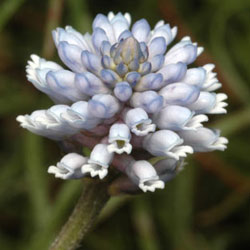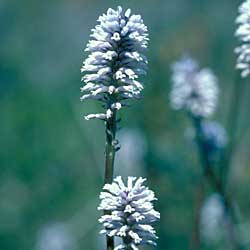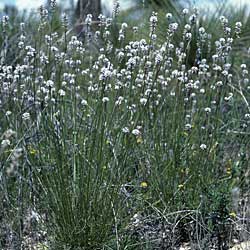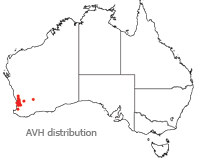Conospermum huegelii
 |
 |
 |
Slender smokebush
Conospermum huegelii R.Br. ex Endl.
Conospermum huegelii (previously known as Conospermum intricatum) is commonly known as Slender smokebush. Conospermum belongs to the family Proteaceae. There are 53 species of Conospermum in Australia of which 42 occur in Western Australia. Conospermum huegelii is endemic to Western Australia.
 C. huegelii naturally occurs from Perth northward, probably associated with winter wet depressions on the eastern side of the Coastal Plain and in the rocky ground on the Darling Scarp and Ridge.
C. huegelii naturally occurs from Perth northward, probably associated with winter wet depressions on the eastern side of the Coastal Plain and in the rocky ground on the Darling Scarp and Ridge.
A perennial herb, rather than a shrub, it has short leafy stems from which arise smooth floral scapes up to 60cm tall with the flowers crowded towards the tips. The flowers are blue and tubular about 0.75cm long, visible from July to October. The leaves are needle-like but soft, about 5-20cm long and incurved.
C. huegelii is an attractive ornamental plant suitable for gardens or containers. The flowers are long lasting and used for decoration.
C. huegelii is quite difficult to establish and grow. Propagation is by cuttings or sown by seed. Vegetative propagation with the aid of a rooting hormone (IBA or combination with NAA) should produce a strike rate of about 50%. It is difficult to grow from seed, taking about a year to germinate. Trials at the ANBG indicate that smoke treatment is not helpful, inhibiting germination;
Choose a weed free site preferably one with no fertilizer history. To maintain weed control during establishment use weed mats or lay 75mm to 100mm of bark mulch. Mulch also conserves moisture and reduces soil temperature during summer. Plant into moist soil and water regularly during establishment particularly on sandy soils.
All new stems should be pruned after flowering to 10 – 20 cm once new stems have appeared, taking care to leave new stem growth on the plant. This helps to promote bushy growth.
C. huegelii is generally short lived in cultivation when grown in dry sandy soils, where it requires regular summer watering and a full sun but protected position. As a container plant it survives for at least 5 years, and is best grown in broken sunlight during summer.
Text by Danielle Romiti (Botanical Intern 2008)
Name Meaning: Conospermum huegeliiConospermum – from cono meaning cone and spermum meaning seeds, referring to the shape of the nut huegelii – named after Karl von Hugel, a 19 th century botanist. |
Acknowledgements
Paul Carmen and Heather Sweet, ANBG Horticultural staff.
References
Parker, J and Malone, M. (2003) ABC Gardening Australia Flora. - The Gardeners Bible Global Book Publishing N.S.W.
Ralph. M. (1997) Growing Australian native plants from seed: for revegetation, tree planting and direct seeding . Murray Ralph/Bushland Horticulture, Melbourne
Rodger, E.W. and Jones, D.L. (1984) Encyclopedia of Australian Plants suitable for cultivation. Lothian Publishing Company Pty Ltd.
Sainsbury, R.M. (1991) A Field Guide to Smokebushes and Honeysuckles. University of W.A Press.
Sharr, F.A (1996). Western Australian Plant Names and their meanings. University of W.A. Press.
Australian Plant Name Index (APNI) Available at http://www.anbg.gov.au/cpbr/databases/apni.html
Seaton, K. (1999, reviewed 2007) Smokebush (Conospermum spp.) for cut flower production. Farmnote 110/99. Department of Agriculture Western Australia. Available at http://www.agric.wa.gov.au/content/HORT/FLOR/cp/f11099.pdf [Accessed Feb 2008]
Western Australian Herbarium (1998–). FloraBase - The Western Australian Flora. Department of Environment and Conservation. Available at http://florabase.calm.wa.gov.au/.
Wikipedia the free encyclopedia (2008). Charles von Hügel . Available at http://en.wikipedia.org/wiki/Charles_von_H%C3%BCgel [Accessed Feb 2008]
![An Australian Government Initiative [logo]](/images/austgovt_brown_90px.gif)

